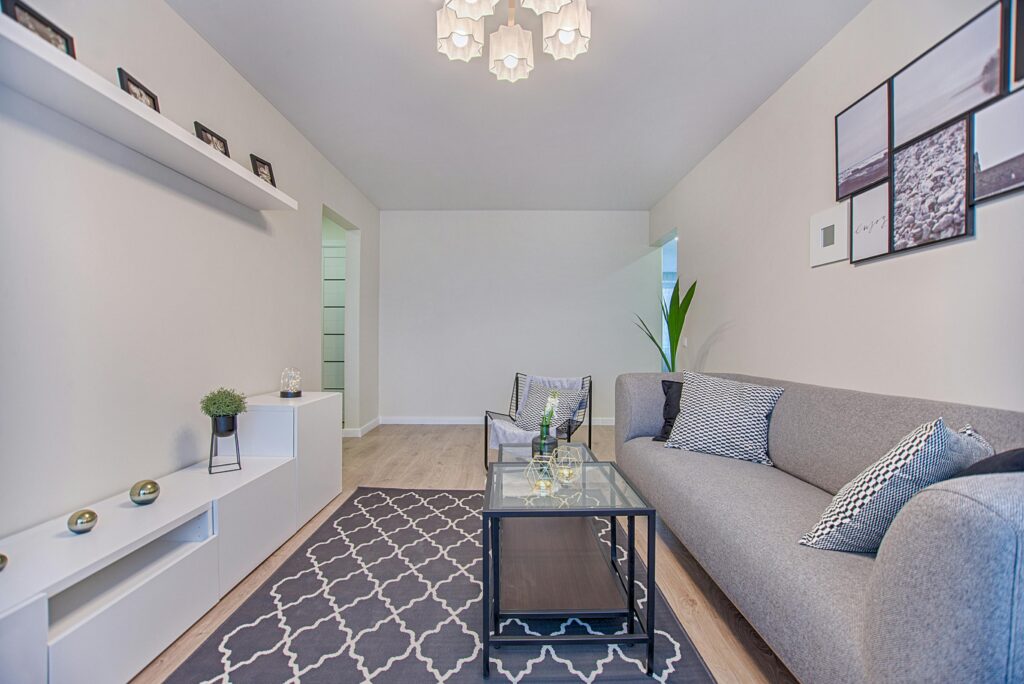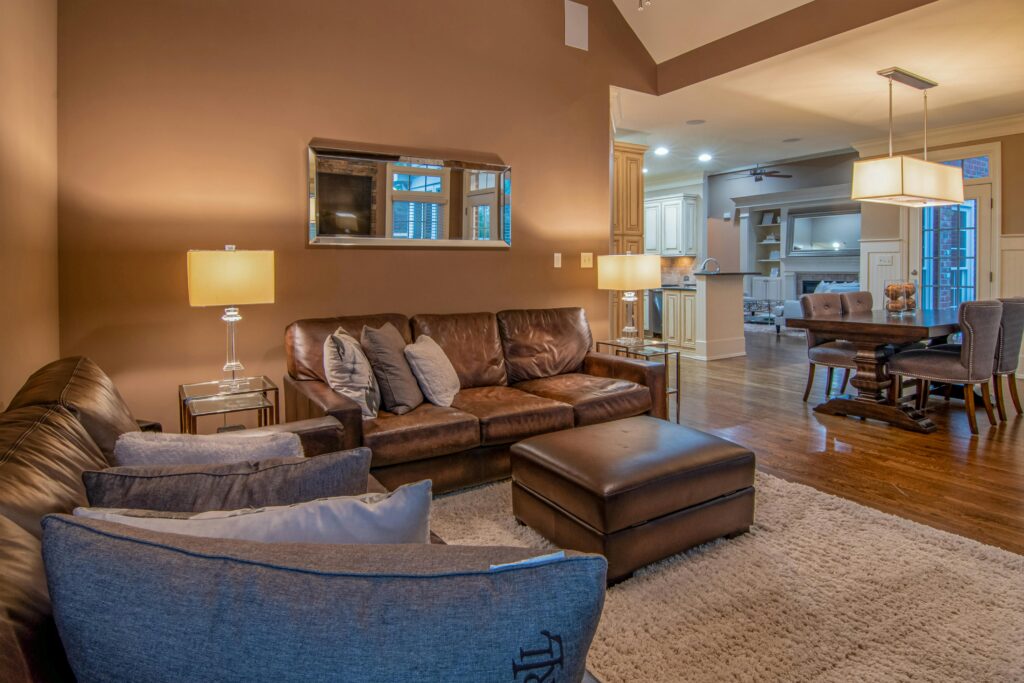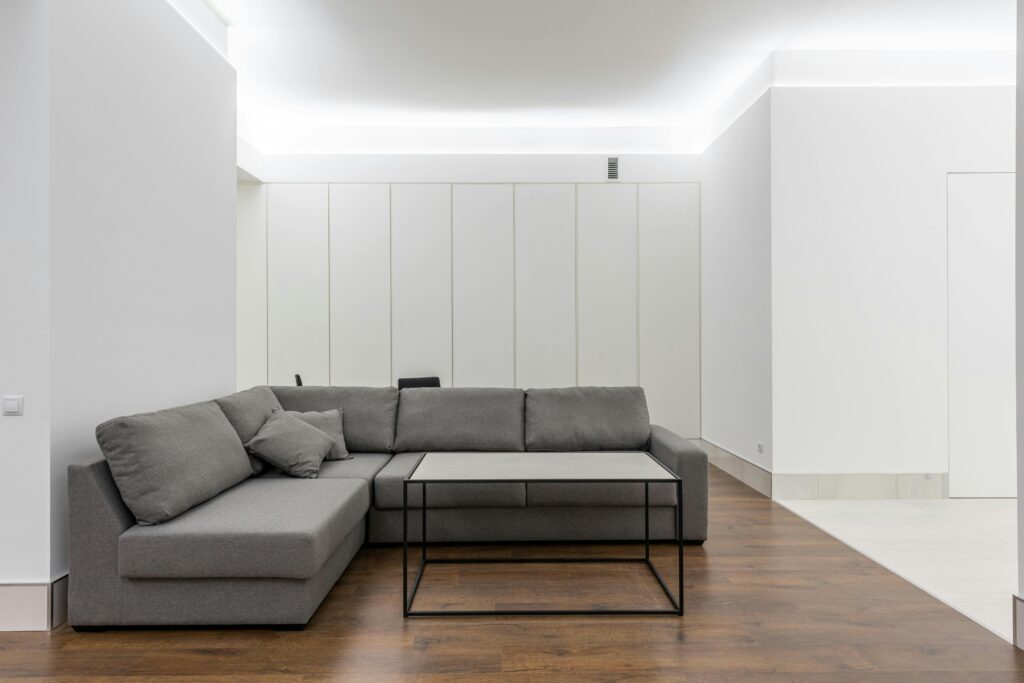Introduction-Living Room
In the realm of interior design, small living rooms present a unique challenge. Limited space often means compromise, but it doesn’t have to equate to sacrificing style or comfort. With thoughtful planning and strategic furniture choices, you can transform even the tiniest living area into a welcoming retreat that reflects your personality and maximizes functionality. In this comprehensive guide, we’ll explore ten ingenious ways to style a small living room using furniture, ensuring that every square foot is optimized for both aesthetics and practicality.

1. Embrace Multi-Functional Pieces:
Small living rooms demand furniture that pulls double duty. Look for pieces that serve more than one purpose, such as a sofa with built-in storage compartments or a coffee table that can also function as a dining surface. These versatile items help conserve space while providing essential functionality, making them indispensable in compact environments.
Discover the art of space optimization with our guide on embracing multi-functional furniture pieces. In this blog, we delve into how savvy furniture selections can transform your living space, focusing on the keyword “furniture.” Learn how to make the most of every square inch with versatile pieces that serve dual purposes, from storage-integrated sofas to wall-mounted shelving solutions. Don’t let limited space cramp your style – explore innovative furniture options to unlock the full potential of your home.
2. Opt for Space-Saving Sofas:
When selecting a sofa for a small living room, prioritize compact designs that won’t overwhelm the space. Consider options like loveseats, apartment-sized sofas, or even sleek sectionals with a low profile. Additionally, choose styles with exposed legs to create a sense of openness and prevent the room from feeling visually weighed down.
In today’s world, where living spaces are often limited, it’s essential to maximize every inch of available space. Multi-functional furniture offers a practical solution, allowing you to make the most of your square footage without sacrificing style or comfort. Whether you’re furnishing a compact apartment, a cozy studio, or a small living room, these versatile pieces can help you create a functional and inviting environment tailored to your needs.
One of the key benefits of multi-functional furniture is its ability to serve dual purposes. From sleeper sofas that provide comfortable seating by day and a cozy bed by night to coffee tables with built-in storage compartments, these pieces are designed to adapt to your changing needs. By investing in furniture that can perform multiple functions, you can maximize the utility of your space and minimize clutter.
Another advantage of multi-functional furniture is its versatility. Many pieces are designed to be modular or customizable, allowing you to configure them in different ways to suit your space. For example, modular shelving systems can be adjusted to fit the dimensions of your room, while sectional sofas can be rearranged to accommodate different seating arrangements. This flexibility enables you to optimize your layout for comfort, traffic flow, and aesthetics.
3. Harness the Power of Modular Furniture:
Modular furniture offers unparalleled flexibility, making it an ideal choice for small living rooms. Experiment with modular sofas or sectionals that allow you to customize the configuration to suit your layout preferences. You can easily rearrange the pieces to accommodate different activities or reconfigure the space for entertaining guests.
Unlock the potential of your living space with modular furniture solutions tailored to your needs. In this blog, we explore the versatility and functionality of modular furniture, centered around the keyword “furniture.” From customizable seating arrangements to adaptable storage solutions, learn how modular pieces can revolutionize the way you design your home. Discover tips on optimizing space, maximizing functionality, and expressing your unique style through the transformative power of modular furniture. Whether you’re furnishing a small apartment or revamping a spacious home, harness the versatility of modular furniture to create a personalized and efficient living environment.

4. Maximize Vertical Storage:
In a small living room, every inch of space counts, including vertical surfaces. Invest in furniture with built-in shelving or consider installing floating shelves to display decorative items without cluttering tabletops or floor space. Wall-mounted cabinets and bookshelves not only add storage but also draw the eye upward, creating the illusion of height and expansiveness.
Learn how to make the most of every inch in your small space by incorporating shelving units, wall-mounted cabinets, and tall bookcases. With our tips and tricks, you’ll transform your living area into a functional and organized oasis, while also boosting your home’s aesthetic appeal. Explore how furniture designed for vertical storage can enhance the functionality and visual appeal of any room, providing stylish solutions for clutter-free living. Whether you’re dealing with a tiny apartment or a cozy nook, our insights will help you unlock the potential of vertical space and elevate your home decor game.
5. Choose Leggy Furniture:
When it comes to furnishing a small living room, airy and leggy furniture reigns supreme. Opt for chairs, tables, and consoles with slender legs that allow light to pass through, visually expanding the room. Avoid bulky, solid pieces that obstruct sightlines and make the space feel cramped. Instead, embrace the delicate elegance of leggy designs to enhance the room’s openness.
In this detailed blog post, we unravel the magic of selecting leggy furniture to elevate your interior design, spotlighting the keyword “furniture.” Delve into the world of elegant and sleek furniture pieces that not only enhance aesthetics but also optimize space. Learn how choosing leggy furniture can create an illusion of openness and airiness in any room, making it feel larger and more inviting. From slender-legged sofas to chic dining tables, explore a myriad of options that add a touch of sophistication to your home decor. Discover expert tips on selecting the perfect leggy furniture to complement your style and transform your living spaces into stylish sanctuaries.
6. Prioritize Streamlined Silhouettes:
Sleek, streamlined furniture is a must-have for small living rooms, as it creates a sense of fluidity and visual harmony. Choose pieces with clean lines and minimal ornamentation to maintain a cohesive look without overwhelming the space. Whether you prefer modern or transitional styles, prioritize simplicity and proportion to achieve a polished aesthetic.
Leggy furniture, characterized by its slender legs and streamlined design, offers numerous benefits beyond aesthetics. By lifting furniture off the ground, these pieces create a sense of visual openness and spaciousness in any room, making them ideal for smaller living spaces. Additionally, their sleek profiles contribute to a modern and sophisticated ambiance, adding a touch of elegance to your decor scheme.
When selecting leggy furniture, consider pieces with clean lines and minimalistic designs. Sofas, armchairs, and coffee tables featuring slender legs can effortlessly anchor a room without overpowering the space. Opting for furniture with exposed legs also allows light to flow freely underneath, enhancing the perception of space and brightness.
In addition to their visual appeal, leggy furniture pieces offer practical benefits as well. Raised off the ground, these items make cleaning and maintenance a breeze, as vacuuming or sweeping underneath becomes hassle-free. This not only contributes to a cleaner and more hygienic living environment but also ensures that your furniture retains its pristine condition for years to come.
7. Incorporate Reflective Surfaces:
Strategically placed mirrors and reflective furniture can work wonders in a small living room, bouncing light around the space and creating the illusion of depth. Consider incorporating mirrored coffee tables, metallic accents, or glass tabletops to add sparkle and dimension. Additionally, positioning mirrors opposite windows or light sources amplifies natural illumination, making the room feel brighter and more spacious.
Reflective surfaces, such as mirrors, glass, polished metals, and high-gloss finishes, play a pivotal role in interior design by bouncing light around a room and creating the illusion of spaciousness. By strategically incorporating these elements into your decor scheme, you can brighten up dark corners, visually enlarge cramped spaces, and add a touch of glamour to your home.
Mirrors are perhaps the most well-known and versatile reflective surface, capable of instantly transforming any room. Placing mirrors opposite windows allows them to capture and amplify natural light, making the space feel brighter and more airy. Additionally, strategically positioning mirrors can create the illusion of depth, making a room appear larger than it actually is. Consider incorporating oversized mirrors as statement pieces or arranging smaller mirrors in groupings to add visual interest and dimension to your walls.
In addition to mirrors, metallic accents, such as brass, chrome, and gold, can introduce reflective qualities into your decor. Whether in the form of light fixtures, furniture legs, or decorative accessories, metallic finishes catch and reflect light, adding a subtle shimmer to your space. Experiment with metallic accents in varying textures and finishes to create a dynamic and visually captivating ambiance.
Glossy finishes, such as lacquered furniture, high-gloss paint, and polished stone surfaces, are another effective way to introduce reflective surfaces into your home. These sleek finishes not only reflect light but also create a smooth and lustrous appearance that exudes sophistication and modernity. Incorporate glossy finishes on furniture pieces, cabinetry, or accent walls to instantly elevate the style quotient of your space.
8. Invest in Transforming Furniture:
For ultimate versatility in a small living room, explore the world of transforming furniture. From convertible sofa beds to extendable dining tables, these innovative pieces seamlessly adapt to changing needs, allowing you to make the most of limited square footage. Whether you’re hosting overnight guests or hosting a dinner party, transforming furniture ensures that your living room remains functional and stylish.
Transforming furniture goes beyond traditional design, offering innovative solutions for maximizing space in today’s compact living spaces. Whether you’re dealing with limited square footage or simply seeking to enhance functionality, these multifunctional pieces are designed to adapt to your changing needs.
One of the key benefits of transforming furniture is its ability to serve multiple purposes without sacrificing style or comfort. From sofa beds that seamlessly transition from seating to sleeping arrangements to extendable dining tables that accommodate guests with ease, these pieces are the epitome of versatility.
Moreover, transforming furniture is designed to optimize every inch of available space, making it ideal for urban dwellers and small-space living. Whether you’re furnishing a studio apartment or a cozy loft, these pieces are engineered to maximize functionality without compromising on aesthetics.
9. Create Zones with Area Rugs:
In an open-concept living space, delineating distinct zones can help define the purpose of each area. Utilize area rugs to anchor furniture groupings and visually separate the living room from adjacent spaces. Opt for rugs with bold patterns or vibrant colors to infuse personality and warmth into the room, enhancing its visual appeal without overwhelming the eye.
When selecting area rugs, consider the size, shape, and material to ensure they complement your existing décor and lifestyle. Choose rugs that are large enough to anchor furniture groupings, providing cohesion and visual continuity within each zone. Additionally, opt for durable materials that can withstand high traffic areas and frequent use.
In open-concept living spaces, area rugs play a crucial role in defining individual areas while maintaining a sense of flow and cohesion. Use rugs to create designated seating or dining areas within a larger space, allowing each zone to feel distinct yet connected to the overall design scheme.
Area rugs also offer an opportunity to inject color, pattern, and texture into your décor, adding visual interest and personality to any room. Experiment with different styles, from bold geometric patterns to subtle textures, to create a cohesive look that reflects your unique taste and style.
In addition to defining zones and adding visual interest, area rugs provide practical benefits as well. By adding an extra layer of cushioning and insulation, rugs can help absorb sound, reduce noise, and create a more comfortable and inviting environment for everyday living.
When styling with area rugs, consider layering multiple rugs to add depth and dimension to your space. Mix and match rugs of different sizes, shapes, and textures to create visual interest and contrast. Layering rugs also allows you to experiment with different patterns and colors, adding personality and flair to your décor.

10. Embrace Minimalism:
When styling a small living room, less is often more. Embrace a minimalist approach by decluttering unnecessary items and opting for furniture with clean, uncluttered lines. Choose a cohesive color palette and limit decorative accents to a few carefully curated pieces to maintain a sense of tranquility and balance. By embracing simplicity and restraint, you can create a serene and inviting environment that feels spacious despite its size.
One of the key principles of minimalism is decluttering, which involves eliminating unnecessary items and keeping only the essentials. Start by assessing each area of your home and identifying items that no longer serve a purpose or bring you joy. Donate, sell, or recycle these items to create a clean and clutter-free environment that promotes focus and tranquility.
Incorporating minimalist design principles into your home décor involves embracing simplicity, functionality, and restraint. Choose furniture with clean lines, neutral colors, and sleek silhouettes to create a sense of openness and visual calmness. Opt for multifunctional pieces that serve a dual purpose and maximize space efficiency without sacrificing style.
When styling with minimalist décor, focus on quality over quantity by investing in well-crafted, timeless pieces that stand the test of time. Choose natural materials such as wood, stone, and leather to add warmth and texture to your space while creating a connection to the natural world. Selecting a few statement pieces that truly resonate with you can have a greater impact than filling your home with unnecessary decorations.
Conclusion:
Styling a small living room with furniture requires careful consideration and strategic planning, but with the right approach, you can transform even the most diminutive space into a stylish and functional oasis. By embracing multi-functional pieces, maximizing vertical storage, and prioritizing streamlined design, you can make every square inch count. Whether you prefer modern minimalism or eclectic charm, these ten tips will help you unlock the full potential of your small living room, creating a cozy retreat that reflects your unique style and personality.